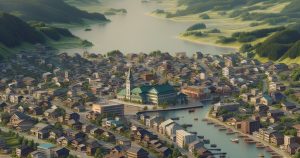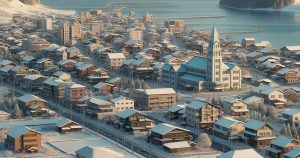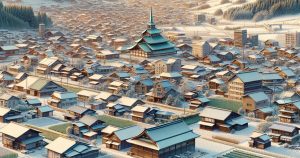| population | 2,639 peoples |
|---|---|
| area | 454.60 km² |
| population density | 5.81 peoples/km² |
Tomamae Town, Hokkaido|A Wind-Powered Coastal Town in Harmony with Nature
Located along the Sea of Japan in northern Hokkaido, Tomamae Town is a quiet coastal community known for its sweeping views, rich Ainu heritage, and powerful winds that have made it one of Hokkaido’s leading wind-power regions. The name “Tomamae” originates from the Ainu words “Toma-oma-i,” meaning “a place where the Corydalis (Ezo-engosaku) grows.”
Once a key area for development during the Showa era, Tomamae has preserved both its pioneering spirit and deep connection with nature. Today, it thrives on fishing, agriculture, and renewable energy. The sight of countless wind turbines spinning gracefully along the Ororon Line has become symbolic of the town’s commitment to sustainability.
Fresh seafood—such as cod, crab, scallops, and sea urchin—defines local life and cuisine. The community also takes pride in its warm local dialect and the continued influence of Ainu culture. Annual festivals such as the Tomamae Onsen Festival and the Tomamae Winter Festival bring residents and visitors together, showcasing the lively spirit of this small but proud Hokkaido town.
Culture & Traditions
Tomamae’s culture reflects a balance between ancient traditions and modern sustainability. The influence of Ainu heritage remains evident in local place names, folktales, and traditional crafts. Residents continue to honor this heritage through cultural workshops and exhibits at the Tomamae Folk Museum.
During the 20th century, the town flourished through agriculture and forestry, and the spirit of cooperation that characterized the early settlers still defines local life today. The Hokkaido dialect, often heard in daily conversations, conveys both friendliness and pride in local identity. Tomamae is also known for its strong environmental awareness, having embraced wind power as a key part of its future.
The Tomamae Onsen Festival features food stalls, music, and performances near the local hot spring, while the Tomamae Winter Festival celebrates snow culture with ice sculptures and snowmobile rides. These events embody the town’s resilience and unity, blending old traditions with modern joy.
Local Specialties
- Seafood from Tomamae: Fresh catches from the Tomamae Fishing Port and Rikibiru Fishing Port include cod, scallops, crab, sea urchin, and shrimp. Visitors can enjoy them at local markets and restaurants.
- Dairy Products: Tomamae’s rich pastures produce creamy butter, cheese, and milk with distinct Hokkaido flavor. Local dairy farms supply both households and gourmet shops across the region.
- Fresh Vegetables: Thanks to its fertile soil and cool climate, Tomamae grows delicious potatoes, carrots, and tomatoes that are highly valued throughout Japan.
- Local Spirits: Potato-based shochu (Japanese liquor) and locally brewed sake, made from pure mountain water, are unique souvenirs that reflect the town’s natural bounty.
Annual Events
- Tomamae Onsen Festival (July): Held at Tomamae Onsen Fuwatto, this summer festival features music, food stalls, and fireworks—an essential part of the local summer.
- Tomamae Winter Festival (February): A joyful event with snow sculptures, sleigh rides, and family-friendly winter games.
- Tomamae Port Festival (August): A marine celebration that honors the sea’s blessings with fishing boat parades, seafood tastings, and folk performances.
- Tomamae Autumn Festival (October): A harvest-themed event that showcases autumn foliage, local food, and handmade crafts.
Access
- By Air: The nearest airport is Asahikawa Airport. It takes about 2.5 hours by car or rental car to reach Tomamae.
- By Train: The former Japan National Railways Haboro Line once served the town but was discontinued in 1987. Currently, there are no train stations in Tomamae.
- By Car: Accessible via National Route 232 from Rumoi (approx. 1.5 hours). Route 239 through the Kiritachi Pass connects the area to northern Hokkaido.
- By Bus: The Engan Bus runs express lines from Sapporo (“Tokkyu Haboro-go”) and Asahikawa (“Tokkyu Asahikawa-go”), stopping at Tomamae Bus Terminal.
Tourist Attractions
- Tomamae Onsen Fuwatto – A seaside hot spring resort with open-air baths overlooking the Sea of Japan and local cuisine made with fresh seafood.
- The Ororon Line (Route 232) – One of Hokkaido’s most scenic drives, featuring coastal wind turbines, wide horizons, and breathtaking sunsets.
- Tomamae Folk Museum – Displays artifacts of Ainu culture, pioneer history, and a detailed exhibit about the 1915 Sankebetsu Brown Bear Incident.
- Sankebetsu Brown Bear Incident Memorial Site – A historical site reproducing Japan’s worst bear attack, complete with full-scale dioramas and interpretive panels.
- Michi-no-Eki “Fuwatto Tomamae” – A roadside rest stop offering local food, souvenirs, and tourist information; includes a hot spring and rest area.








